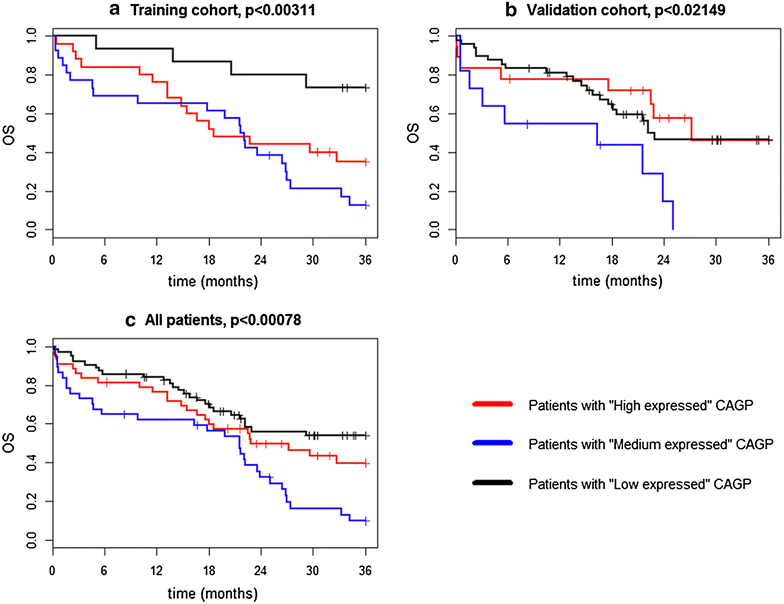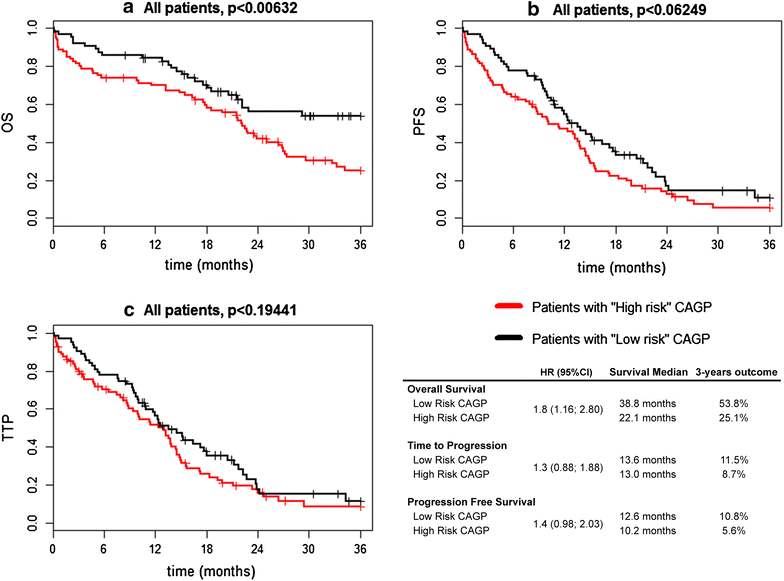Centrosome associated genes pattern for risk sub-stratification in multiple myeloma
- PMID: 27234807
- PMCID: PMC4884414
- DOI: 10.1186/s12967-016-0906-9
Centrosome associated genes pattern for risk sub-stratification in multiple myeloma
Abstract
Background: The genome of multiple myeloma (MM) cells is extremely unstable, characterized by a complex combination of structure and numerical abnormalities. It seems that there are several "myeloma subgroups" which differ in expression profile, clinical manifestations, prognoses and treatment response. In our previous work, the list of 35 candidate genes with a known role in carcinogenesis and associated with centrosome structure/function was used as a display of molecular heterogeneity with an impact in myeloma pathogenesis. The current study was devoted to establish a risk stratification model based on the aforementioned candidate genes.
Methods: A total of 151 patients were included in this study. CD138+ cells were separated by magnetic-activated cell sorting (MACS). Gene expression profiling (GEP) and Interphase FISH with cytoplasmic immunoglobulin light chain staining (cIg FISH) were performed on plasma cells (PCs). All statistical analyses were performed using freeware R and its additional packages. Training and validation cohort includes 73 and 78 patients, respectively.
Results: We have finally established a model that includes 12 selected genes (centrosome associated gene pattern, CAGP) which appears to be an independent prognostic factor for MM stratification. We have shown that the new CAGP model can sub-stratify prognosis in patients without TP53 loss as well as in IMWG high risk patients' group.
Conclusions: We assume that newly established risk stratification model complements the current prognostic panel used in multiple myeloma and refines the classification of patients in relation to the disease risks. This approach can be used independently as well as in combination with other factors.
Keywords: Gene expression profiling; Multiple myeloma; Risk stratification.
Figures


Similar articles
-
Clinical implication of centrosome amplification and expression of centrosomal functional genes in multiple myeloma.J Transl Med. 2013 Mar 23;11:77. doi: 10.1186/1479-5876-11-77. J Transl Med. 2013. PMID: 23522059 Free PMC article.
-
Molecular heterogeneity and centrosome-associated genes in multiple myeloma.Leuk Lymphoma. 2013 Sep;54(9):1982-8. doi: 10.3109/10428194.2013.764416. Epub 2013 Feb 18. Leuk Lymphoma. 2013. PMID: 23323949
-
The flow cytometry-defined light chain cytoplasmic immunoglobulin index and an associated 12-gene expression signature are independent prognostic factors in multiple myeloma.Leukemia. 2015 Aug;29(8):1713-20. doi: 10.1038/leu.2015.65. Epub 2015 Mar 10. Leukemia. 2015. PMID: 25753926 Free PMC article.
-
Multiple myeloma.Hematology Am Soc Hematol Educ Program. 2004:237-56. doi: 10.1182/asheducation-2004.1.237. Hematology Am Soc Hematol Educ Program. 2004. PMID: 15561686 Review.
-
Prognostic and therapeutic significance of myeloma genetics and gene expression profiling.J Clin Oncol. 2005 Sep 10;23(26):6339-44. doi: 10.1200/JCO.2005.05.023. J Clin Oncol. 2005. PMID: 16155017 Review.
Cited by
-
Comprehensive small RNA-sequencing of primary myeloma cells identifies miR-105-5p as a predictor of patient survival.Br J Cancer. 2023 Feb;128(4):656-664. doi: 10.1038/s41416-022-02065-1. Epub 2022 Nov 29. Br J Cancer. 2023. PMID: 36446884 Free PMC article.
-
Development and Validation of a 9-Gene Prognostic Signature in Patients With Multiple Myeloma.Front Oncol. 2019 Jan 8;8:615. doi: 10.3389/fonc.2018.00615. eCollection 2018. Front Oncol. 2019. PMID: 30671382 Free PMC article.
-
Prognostic model for multiple myeloma progression integrating gene expression and clinical features.Gigascience. 2019 Dec 1;8(12):giz153. doi: 10.1093/gigascience/giz153. Gigascience. 2019. PMID: 31886876 Free PMC article.
-
PSMB7 Is a Key Gene Involved in the Development of Multiple Myeloma and Resistance to Bortezomib.Front Oncol. 2021 Jul 23;11:684232. doi: 10.3389/fonc.2021.684232. eCollection 2021. Front Oncol. 2021. PMID: 34367968 Free PMC article.
-
Refining precision prognostics in multiple myeloma: loss of miR-221/222 cluster in CD138+ plasma cells results in short-term progression and worse treatment outcome.Blood Cancer J. 2025 Mar 15;15(1):41. doi: 10.1038/s41408-025-01248-2. Blood Cancer J. 2025. PMID: 40089465 Free PMC article.
References
-
- Fonseca R, Bergsagel PL, Drach J, Shaughnessy J, Gutierrez N, Stewart AK, Morgan G, Van Ness B, Chesi M, Minvielle S, et al. International Myeloma Working Group molecular classification of multiple myeloma: spotlight review. Leukemia. 2009;23:2210–2221. doi: 10.1038/leu.2009.174. - DOI - PMC - PubMed
-
- Harousseau JL, Shaughnessy J, Richardson P. Multiple myeloma. Hematology Am Soc Hematol Educ Program. 2004;25:237–256. - PubMed
Publication types
MeSH terms
Substances
LinkOut - more resources
Full Text Sources
Other Literature Sources
Medical
Research Materials
Miscellaneous

